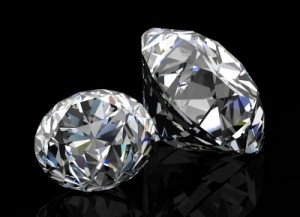 With Valentine’s Day just a few weeks away, we’ve started to see romance on the minds of many of our customers. For some, the holiday is bringing them in for earrings, pendants or other colored gemstone pieces. But for others this can also be the time to make that most important purchase – the diamond engagement ring.
With Valentine’s Day just a few weeks away, we’ve started to see romance on the minds of many of our customers. For some, the holiday is bringing them in for earrings, pendants or other colored gemstone pieces. But for others this can also be the time to make that most important purchase – the diamond engagement ring.
Continuing our series on the 4 C’s of diamond, this month’s installment is all about color. If you’re just tuning in, you can catch yourself up on Cut and Clarity by following the included links.
An interesting irony, a diamond’s “color grade” means, in actuality, its lack of color. A structurally perfect and chemically pure diamond has no hue, like pure water, and this lack of color gives it a higher value. A totally colorless diamond allows light to pass through it easily, resulting in a rainbow spectrum of light dispersed from the stone.
The rating of a diamond’s color does not pertain to the face of the diamond, but is a grade for the body color of the stone. Assessing color is best done by looking at the diamond on its side, against a white background, underneath a daylight fluorescent bulb. The appearance of the stone can be influenced by different types of light and reflections from other elements, and these controls can ensure you have the best vantage point.
We use the GIA’s D-to-Z color-grading system, which measures the degree of a diamond’s color purity by comparing a stone under set lighting and specific viewing conditions to stones of established color value. Stones of D/E/F color grade are colorless, while T/W/Z have the most yellow in them.
While there’s a variety of color-grading systems can be applied to colorless diamonds, diamonds actually come in a variety of actual colors as well (i.e. blue, red and pink). While all diamonds have the same mineral composition, it’s the stone’s chemical composition that influences its color.
For even more “insider information” on how to best make a diamond purchase, be sure to read our article on “The Dangers of Buying Diamonds Online”. This piece is packed full of tips for selecting the perfect stone (useful whether you’re attempting to purchase online or in person).
It’s our hope that the explanations above have added even more confidence to your diamond shopping experience – After all, the more knowledge you have about what exactly it is you’re looking for, the more likely you are to find it. And if you’re left with any questions about color or diamonds in general, we’d be happy to help you with answers. Feel free to contact us online, by phone or by stopping in. We look forward to seeing you!
Announcements
-

The Top 10 Tips on How to Choose an Engagement Ring
March 14, 2025 at 7:46 am
-

Top 2025 Jewelry Design Trends
March 7, 2025 at 2:34 pm
-
Stone Jewelry’s Ho-Ho-Holiday Hours
December 9, 2021 at 3:35 pm
-

Stones Jewelry on Screen: An Invitation to Visit Us From Home
December 11, 2020 at 9:57 pm
-

The Bear & The Rag Doll: A Love Story
November 24, 2020 at 4:37 pm
-

Come On In! Stones Jewelry Reopens Its Doors to Guests
June 8, 2020 at 8:40 am
-

Stones Jewelry Resumes Battery Replacements & Repairs
May 15, 2020 at 9:30 am
-

Stones Jewelry’s Top 5 For Mother’s Day & Gift Giving
May 7, 2020 at 9:33 pm
